Alfa Romeo 4C Spider 2019 Owner's Manual
Manufacturer: ALFA ROMEO, Model Year: 2019, Model line: 4C Spider, Model: Alfa Romeo 4C Spider 2019Pages: 292, PDF Size: 3.25 MB
Page 201 of 292
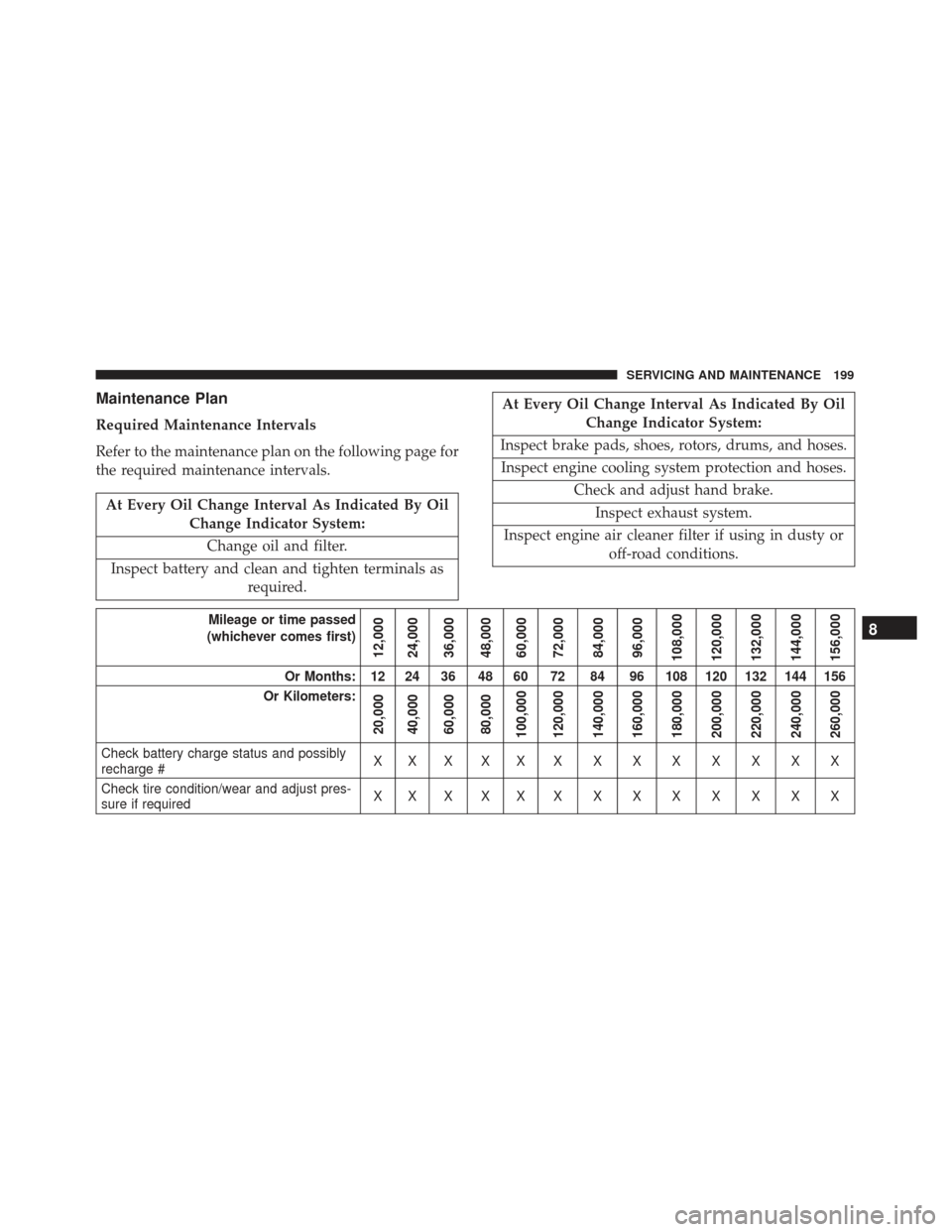
Maintenance Plan
Required Maintenance Intervals
Refer to the maintenance plan on the following page for
the required maintenance intervals.
At Every Oil Change Interval As Indicated By OilChange Indicator System:
Change oil and filter.
Inspect battery and clean and tighten terminals as required.
At Every Oil Change Interval As Indicated By OilChange Indicator System:
Inspect brake pads, shoes, rotors, drums, and hoses. Inspect engine cooling system protection and hoses. Check and adjust hand brake.Inspect exhaust system.
Inspect engine air cleaner filter if using in dusty or off-road conditions.
Mileage or time passed
(whichever comes first)
12,000
24,000
36,000
48,000
60,000
72,000
84,000
96,000
108,000
120,000
132,000
144,000
156,000
Or Months: 12 24 36 48 60 72 84 96 108 120 132 144 156
Or Kilometers:
20,000
40,000
60,000
80,000
100,000
120,000
140,000
160,000
180,000
200,000
220,000
240,000
260,000
Check battery charge status and possibly
recharge # XXXXXXXXXXXXX
Check tire condition/wear and adjust pres-
sure if required XXXXXXXXXXXXX
8
SERVICING AND MAINTENANCE 199
Page 202 of 292
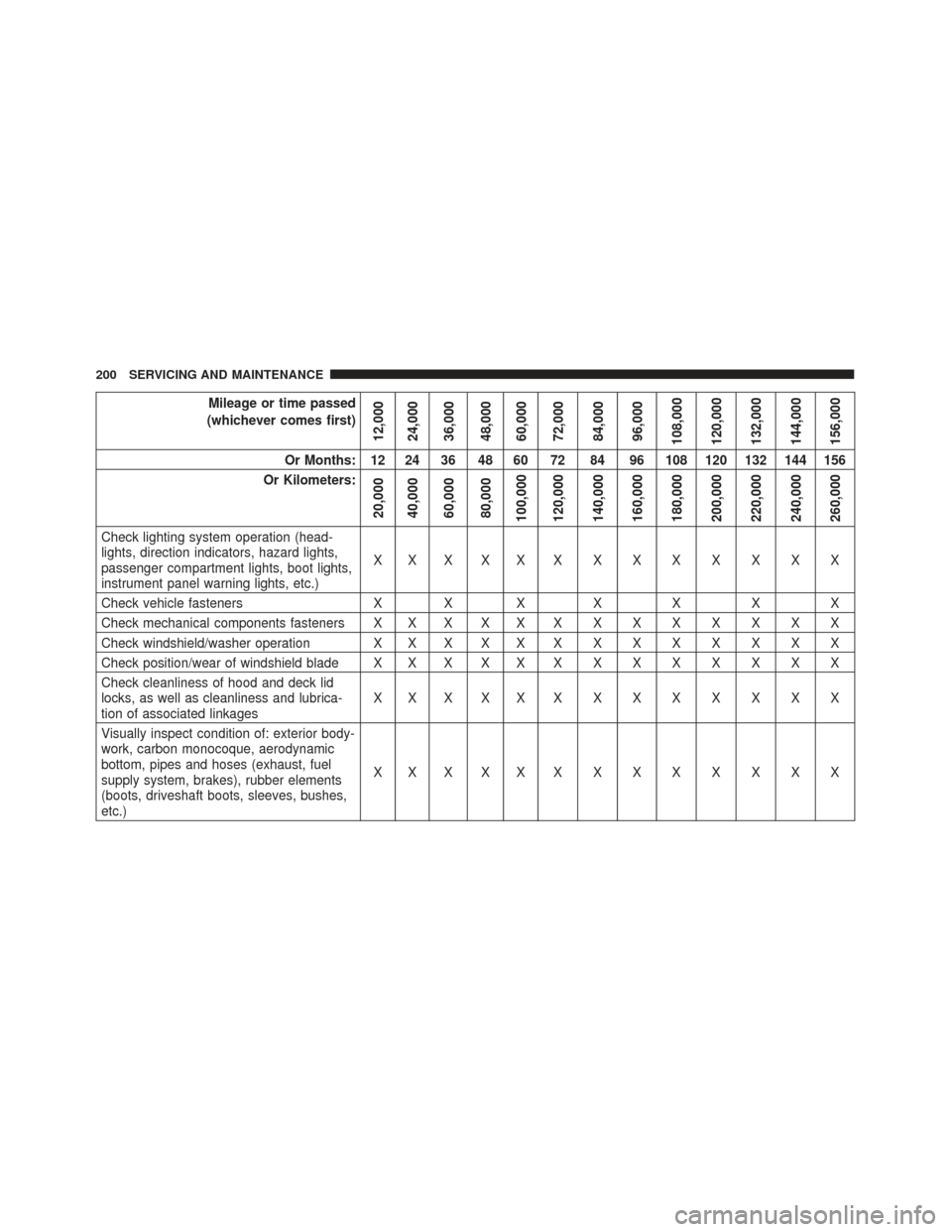
Mileage or time passed
(whichever comes first)
12,000
24,000
36,000
48,000
60,000
72,000
84,000
96,000
108,000
120,000
132,000
144,000
156,000
Or Months: 12 24 36 48 60 72 84 96 108 120 132 144 156
Or Kilometers:
20,000
40,000
60,000
80,000
100,000
120,000
140,000
160,000
180,000
200,000
220,000
240,000
260,000
Check lighting system operation (head-
lights, direction indicators, hazard lights,
passenger compartment lights, boot lights,
instrument panel warning lights, etc.) XXXXXXXXXXXXX
Check vehicle fasteners X X X X X X X
Check mechanical components fasteners X X X X X X X X XXXXX
Check windshield/washer operation X X X X X X X X XXXXX
Check position/wear of windshield blade X X X X X X X X XXXXX
Check cleanliness of hood and deck lid
locks, as well as cleanliness and lubrica-
tion of associated linkages XXXXXXXXXXXXX
Visually inspect condition of: exterior body-
work, carbon monocoque, aerodynamic
bottom, pipes and hoses (exhaust, fuel
supply system, brakes), rubber elements
(boots, driveshaft boots, sleeves, bushes,
etc.) XXXXXXXXXXXXX
200 SERVICING AND MAINTENANCE
Page 203 of 292
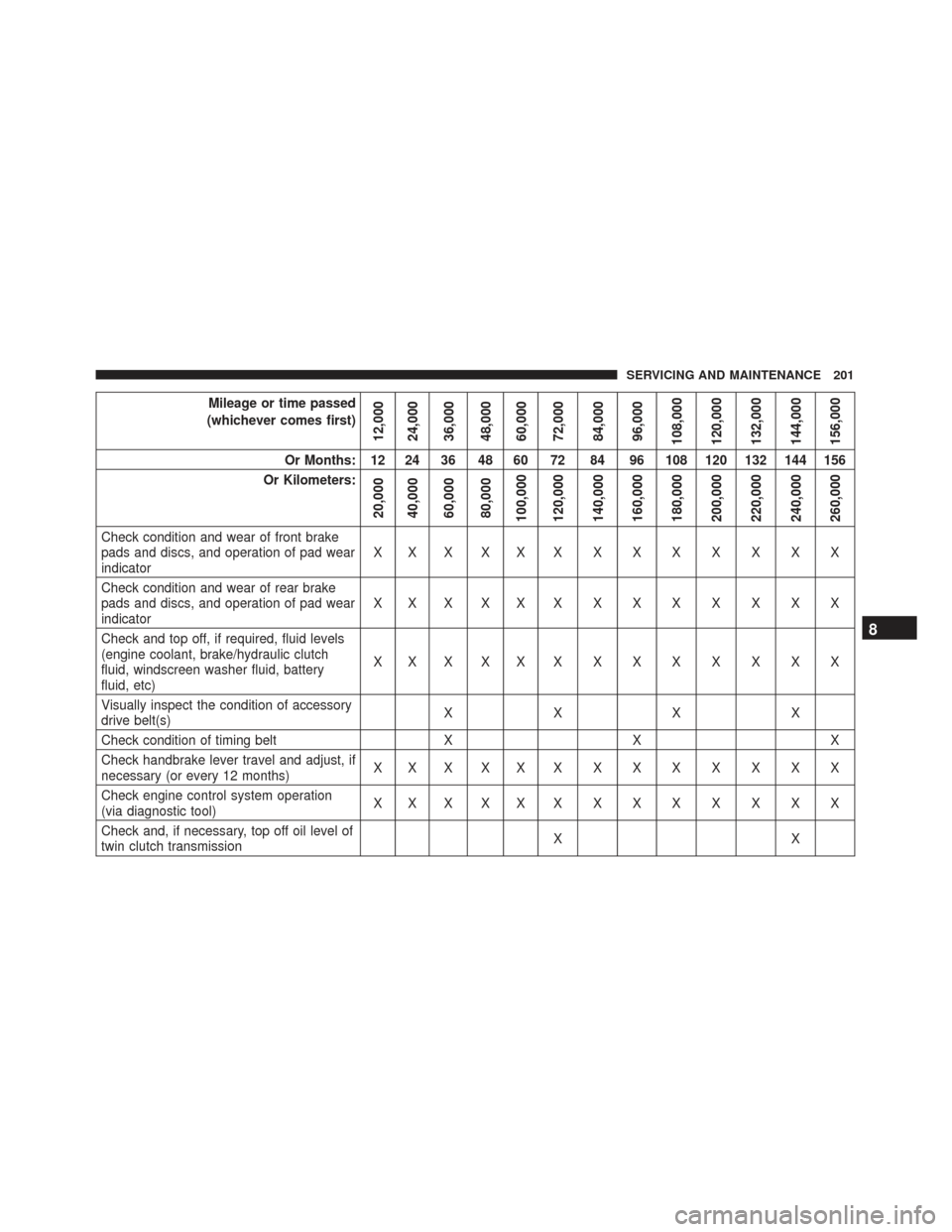
Mileage or time passed
(whichever comes first)
12,000
24,000
36,000
48,000
60,000
72,000
84,000
96,000
108,000
120,000
132,000
144,000
156,000
Or Months: 12 24 36 48 60 72 84 96 108 120 132 144 156
Or Kilometers:
20,000
40,000
60,000
80,000
100,000
120,000
140,000
160,000
180,000
200,000
220,000
240,000
260,000
Check condition and wear of front brake
pads and discs, and operation of pad wear
indicator XXXXXXXXXXXXX
Check condition and wear of rear brake
pads and discs, and operation of pad wear
indicator XXXXXXXXXXXXX
Check and top off, if required, fluid levels
(engine coolant, brake/hydraulic clutch
fluid, windscreen washer fluid, battery
fluid, etc) XXXXXXXXXXXXX
Visually inspect the condition of accessory
drive belt(s) XX X X
Check condition of timing belt X X X
Check handbrake lever travel and adjust, if
necessary (or every 12 months) XXXXXXXXXXXXX
Check engine control system operation
(via diagnostic tool) XXXXXXXXXXXXX
Check and, if necessary, top off oil level of
twin clutch transmission XX
8
SERVICING AND MAINTENANCE 201
Page 204 of 292
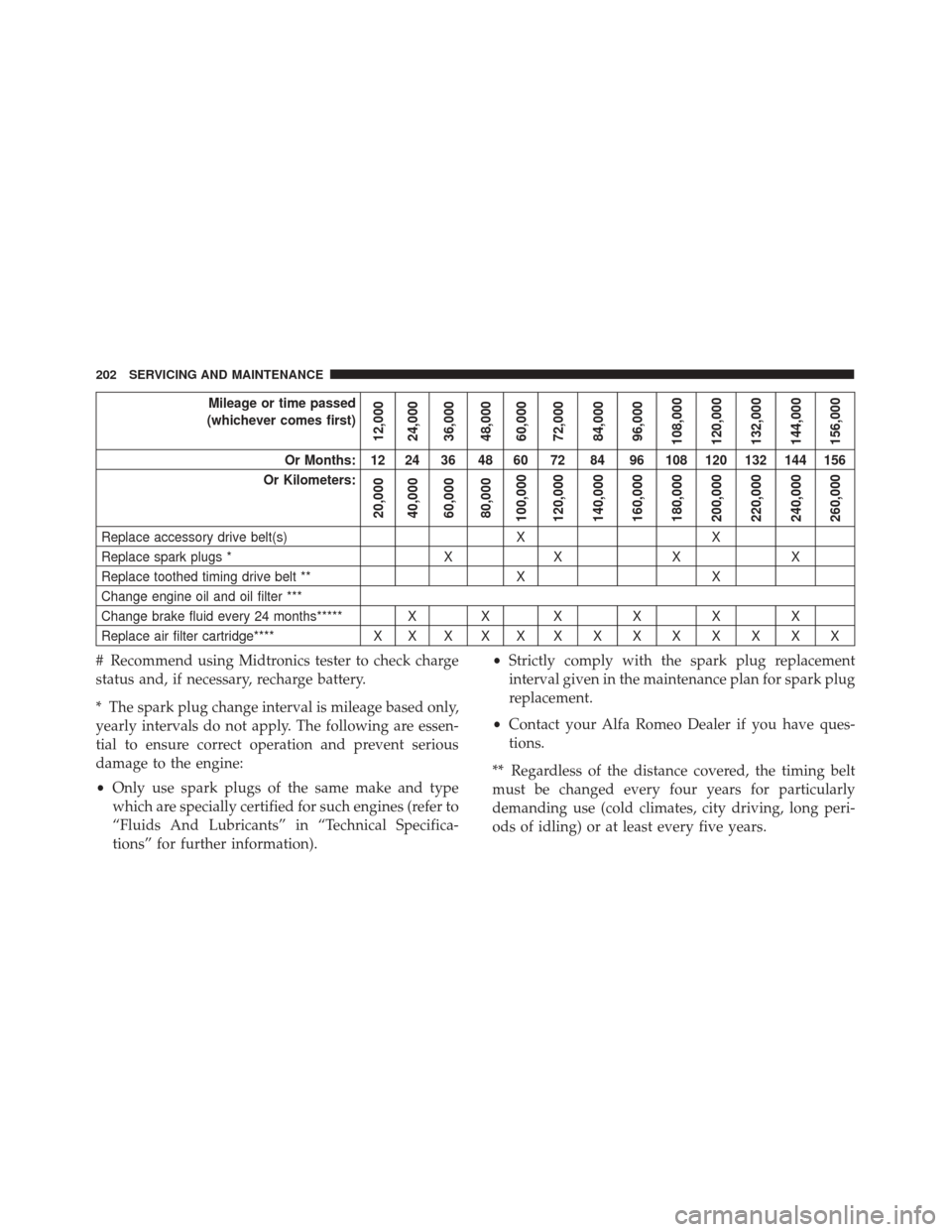
Mileage or time passed
(whichever comes first)
12,000
24,000
36,000
48,000
60,000
72,000
84,000
96,000
108,000
120,000
132,000
144,000
156,000
Or Months: 12 24 36 48 60 72 84 96 108 120 132 144 156
Or Kilometers:
20,000
40,000
60,000
80,000
100,000
120,000
140,000
160,000
180,000
200,000
220,000
240,000
260,000
Replace accessory drive belt(s) XX
Replace spark plugs * XX X X
Replace toothed timing drive belt ** XX
Change engine oil and oil filter ***
Change brake fluid every 24 months***** X X X XX X
Replace air filter cartridge**** X X X X X X X X XXXXX
# Recommend using Midtronics tester to check charge
status and, if necessary, recharge battery.
* The spark plug change interval is mileage based only,
yearly intervals do not apply. The following are essen-
tial to ensure correct operation and prevent serious
damage to the engine:
•Only use spark plugs of the same make and type
which are specially certified for such engines (refer to
“Fluids And Lubricants” in “Technical Specifica-
tions” for further information). •
Strictly comply with the spark plug replacement
interval given in the maintenance plan for spark plug
replacement.
• Contact your Alfa Romeo Dealer if you have ques-
tions.
** Regardless of the distance covered, the timing belt
must be changed every four years for particularly
demanding use (cold climates, city driving, long peri-
ods of idling) or at least every five years.
202 SERVICING AND MAINTENANCE
Page 205 of 292
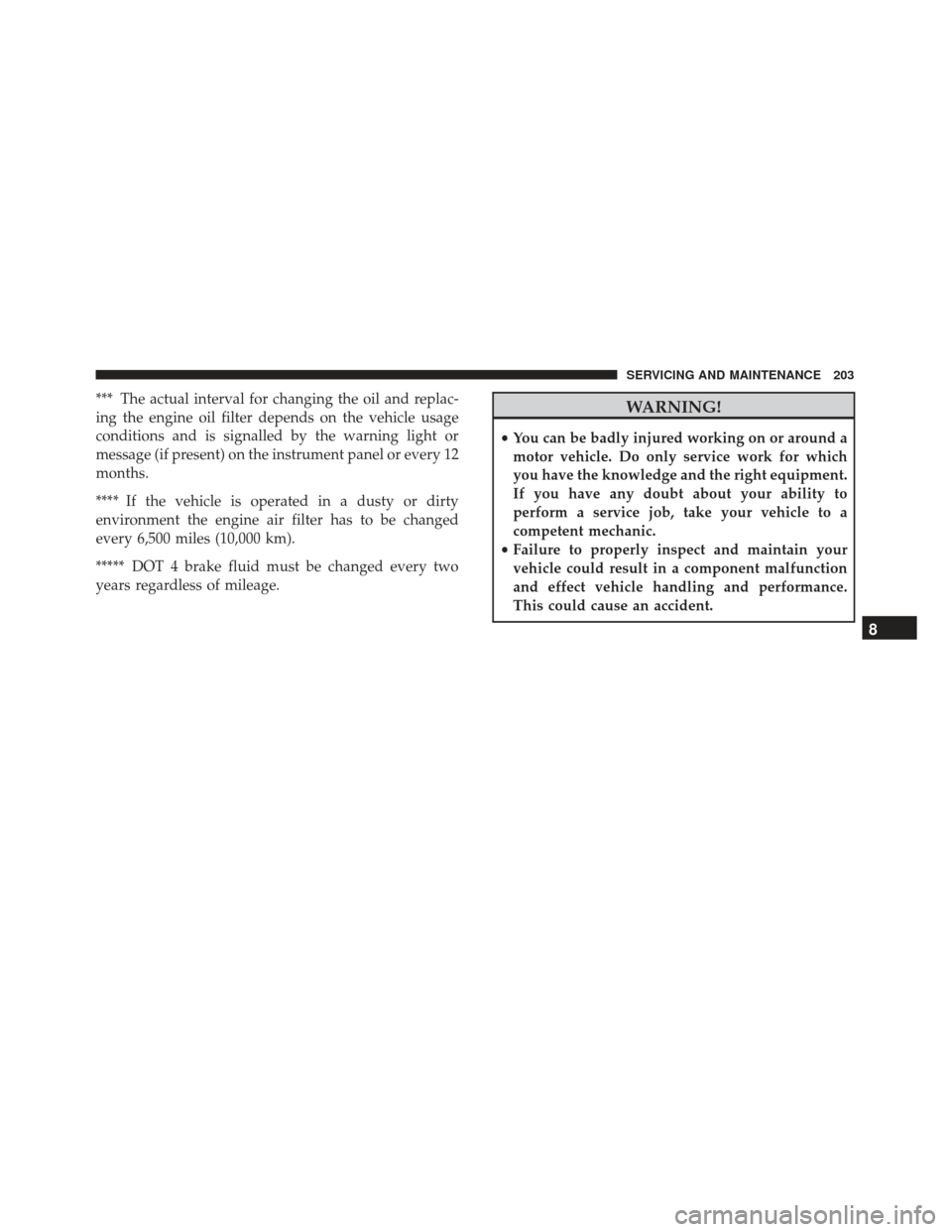
*** The actual interval for changing the oil and replac-
ing the engine oil filter depends on the vehicle usage
conditions and is signalled by the warning light or
message (if present) on the instrument panel or every 12
months.
**** If the vehicle is operated in a dusty or dirty
environment the engine air filter has to be changed
every 6,500 miles (10,000 km).
***** DOT 4 brake fluid must be changed every two
years regardless of mileage.WARNING!
•You can be badly injured working on or around a
motor vehicle. Do only service work for which
you have the knowledge and the right equipment.
If you have any doubt about your ability to
perform a service job, take your vehicle to a
competent mechanic.
• Failure to properly inspect and maintain your
vehicle could result in a component malfunction
and effect vehicle handling and performance.
This could cause an accident.
8
SERVICING AND MAINTENANCE 203
Page 206 of 292
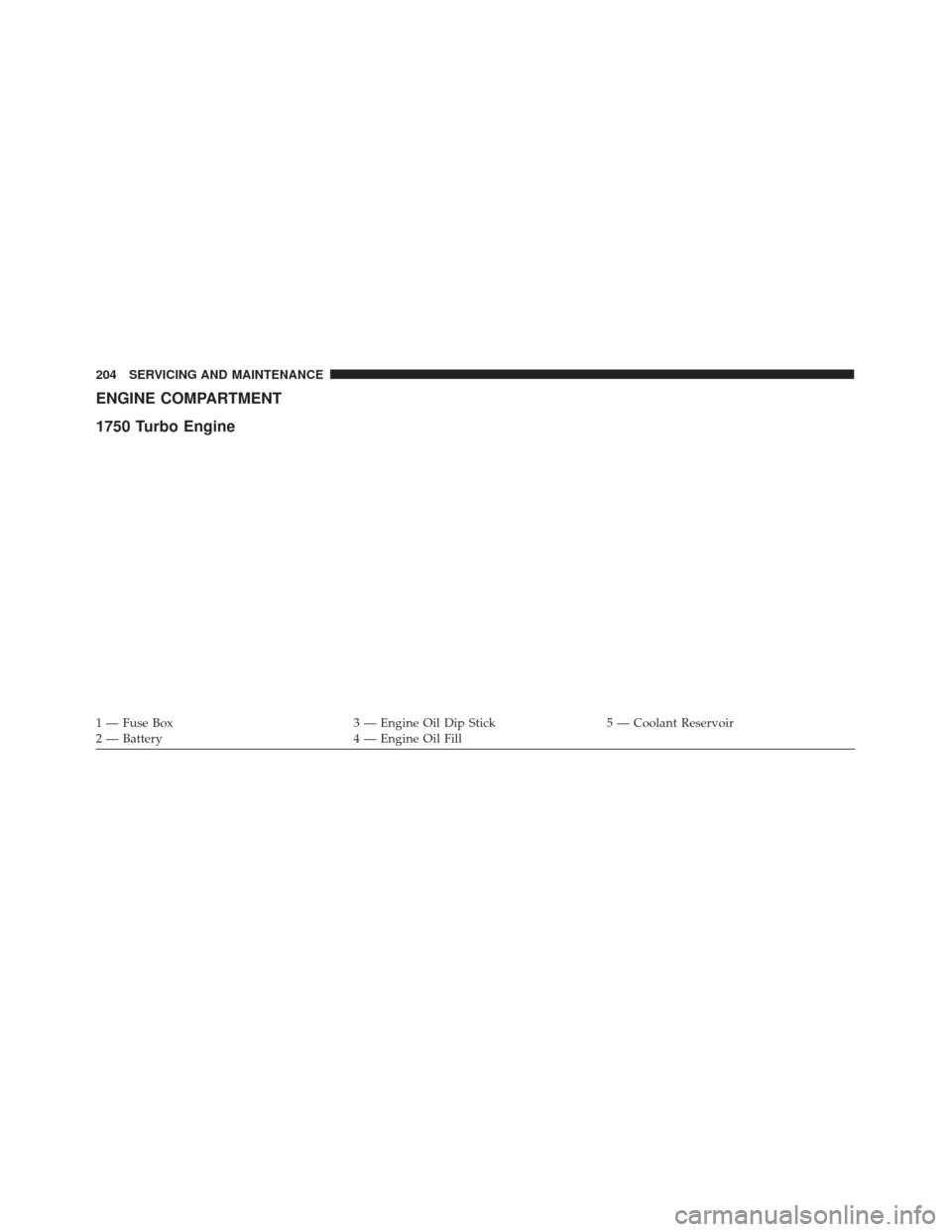
ENGINE COMPARTMENT
1750 Turbo Engine
1 — Fuse Box3 — Engine Oil Dip Stick5 — Coolant Reservoir
2 — Battery 4 — Engine Oil Fill
204 SERVICING AND MAINTENANCE
Page 207 of 292
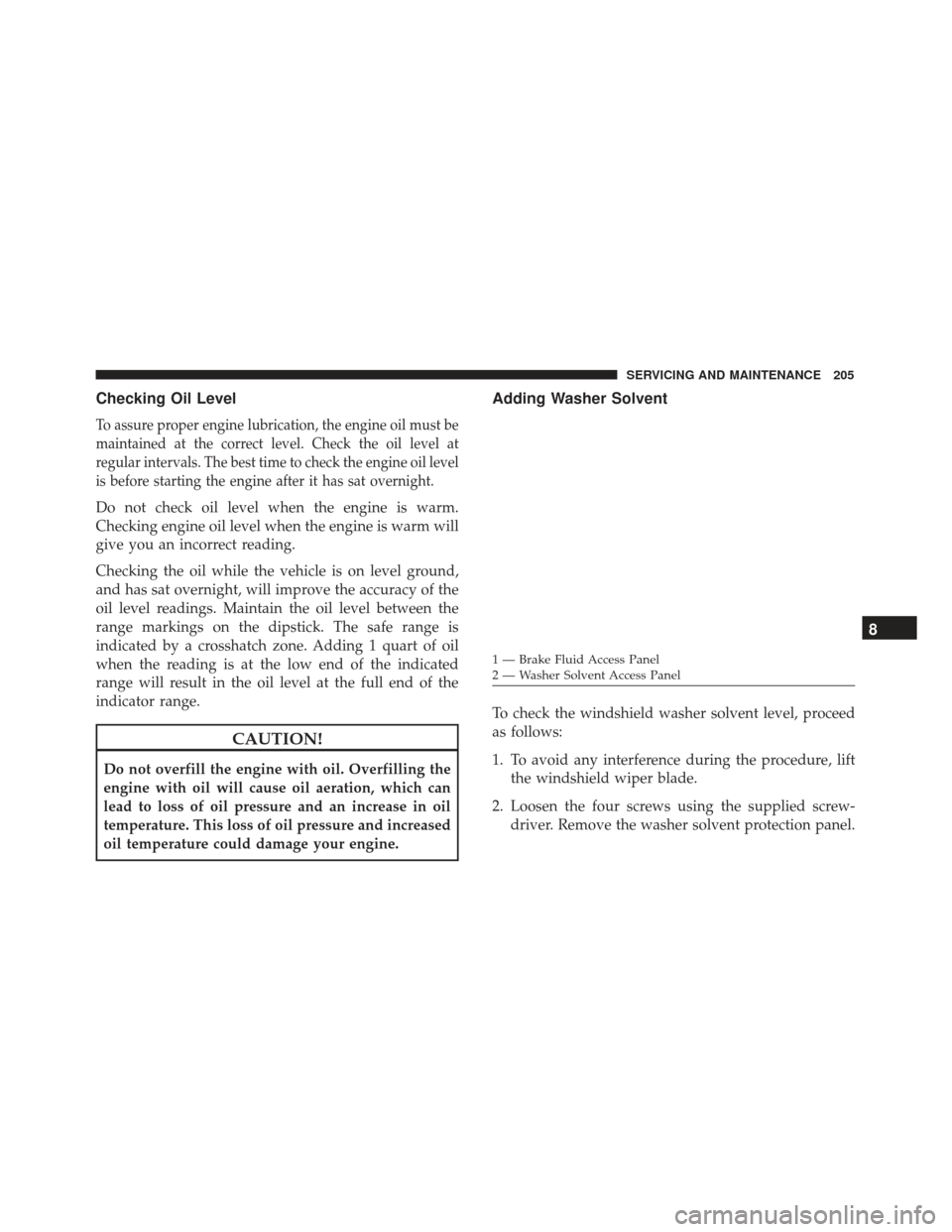
Checking Oil Level
To assure proper engine lubrication, the engine oil must be
maintained at the correct level. Check the oil level at
regular intervals. The best time to check the engine oil level
is before starting the engine after it has sat overnight.
Do not check oil level when the engine is warm.
Checking engine oil level when the engine is warm will
give you an incorrect reading.
Checking the oil while the vehicle is on level ground,
and has sat overnight, will improve the accuracy of the
oil level readings. Maintain the oil level between the
range markings on the dipstick. The safe range is
indicated by a crosshatch zone. Adding 1 quart of oil
when the reading is at the low end of the indicated
range will result in the oil level at the full end of the
indicator range.
CAUTION!
Do not overfill the engine with oil. Overfilling the
engine with oil will cause oil aeration, which can
lead to loss of oil pressure and an increase in oil
temperature. This loss of oil pressure and increased
oil temperature could damage your engine.
Adding Washer Solvent
To check the windshield washer solvent level, proceed
as follows:
1. To avoid any interference during the procedure, liftthe windshield wiper blade.
2. Loosen the four screws using the supplied screw- driver. Remove the washer solvent protection panel.
1 — Brake Fluid Access Panel
2 — Washer Solvent Access Panel
8
SERVICING AND MAINTENANCE 205
Page 208 of 292
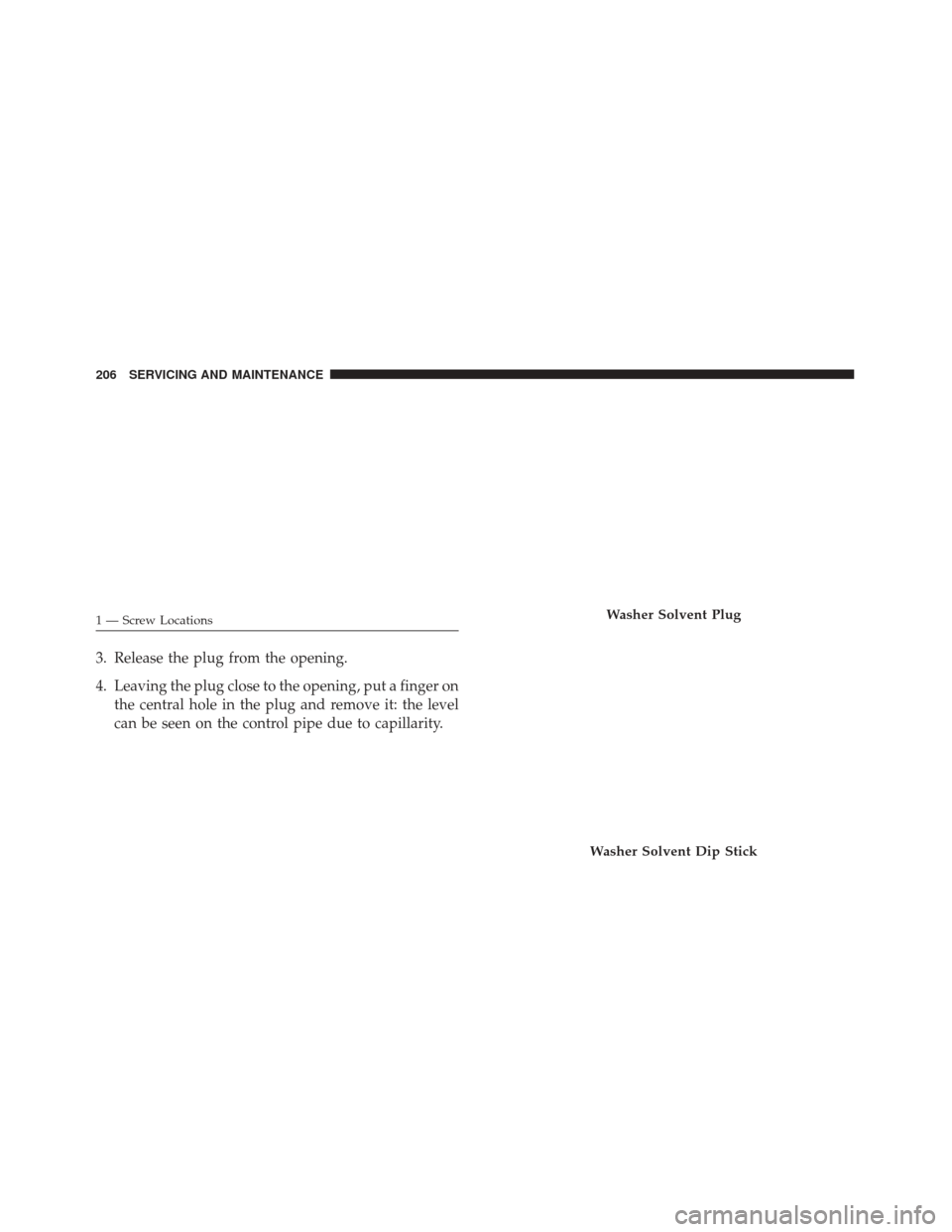
3. Release the plug from the opening.
4. Leaving the plug close to the opening, put a finger onthe central hole in the plug and remove it: the level
can be seen on the control pipe due to capillarity.
1 — Screw LocationsWasher Solvent Plug
Washer Solvent Dip Stick
206 SERVICING AND MAINTENANCE
Page 209 of 292
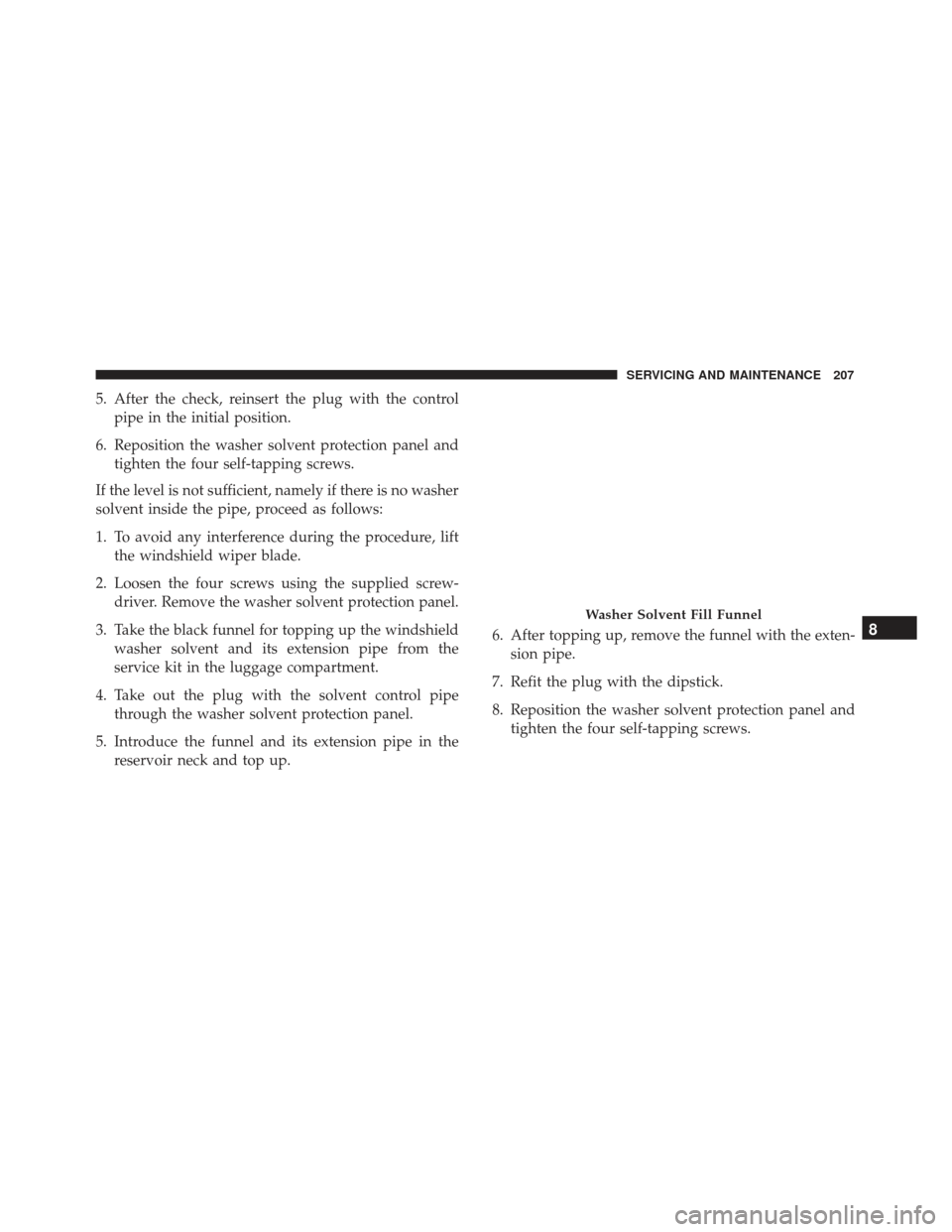
5. After the check, reinsert the plug with the controlpipe in the initial position.
6. Reposition the washer solvent protection panel and tighten the four self-tapping screws.
If the level is not sufficient, namely if there is no washer
solvent inside the pipe, proceed as follows:
1. To avoid any interference during the procedure, lift the windshield wiper blade.
2. Loosen the four screws using the supplied screw- driver. Remove the washer solvent protection panel.
3. Take the black funnel for topping up the windshield washer solvent and its extension pipe from the
service kit in the luggage compartment.
4. Take out the plug with the solvent control pipe through the washer solvent protection panel.
5. Introduce the funnel and its extension pipe in the reservoir neck and top up. 6. After topping up, remove the funnel with the exten-
sion pipe.
7. Refit the plug with the dipstick.
8. Reposition the washer solvent protection panel and tighten the four self-tapping screws.
Washer Solvent Fill Funnel
8
SERVICING AND MAINTENANCE 207
Page 210 of 292
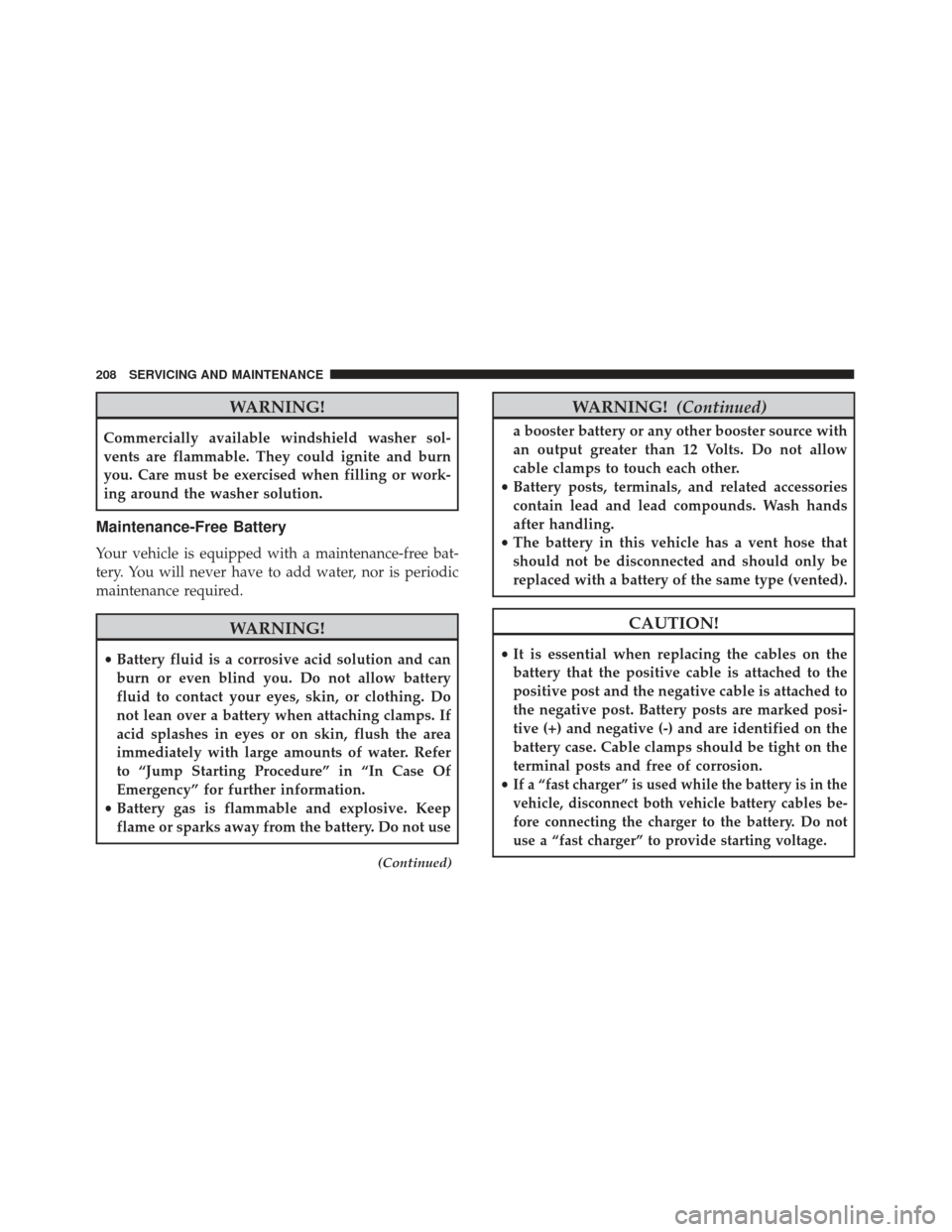
WARNING!
Commercially available windshield washer sol-
vents are flammable. They could ignite and burn
you. Care must be exercised when filling or work-
ing around the washer solution.
Maintenance-Free Battery
Your vehicle is equipped with a maintenance-free bat-
tery. You will never have to add water, nor is periodic
maintenance required.
WARNING!
•Battery fluid is a corrosive acid solution and can
burn or even blind you. Do not allow battery
fluid to contact your eyes, skin, or clothing. Do
not lean over a battery when attaching clamps. If
acid splashes in eyes or on skin, flush the area
immediately with large amounts of water. Refer
to “Jump Starting Procedure” in “In Case Of
Emergency” for further information.
• Battery gas is flammable and explosive. Keep
flame or sparks away from the battery. Do not use
(Continued)
WARNING! (Continued)
a booster battery or any other booster source with
an output greater than 12 Volts. Do not allow
cable clamps to touch each other.
• Battery posts, terminals, and related accessories
contain lead and lead compounds. Wash hands
after handling.
• The battery in this vehicle has a vent hose that
should not be disconnected and should only be
replaced with a battery of the same type (vented).
CAUTION!
• It is essential when replacing the cables on the
battery that the positive cable is attached to the
positive post and the negative cable is attached to
the negative post. Battery posts are marked posi-
tive (+) and negative (-) and are identified on the
battery case. Cable clamps should be tight on the
terminal posts and free of corrosion.
•
If a “fast charger” is used while the battery is in the
vehicle, disconnect both vehicle battery cables be-
fore connecting the charger to the battery. Do not
use a “fast charger” to provide starting voltage.
208 SERVICING AND MAINTENANCE